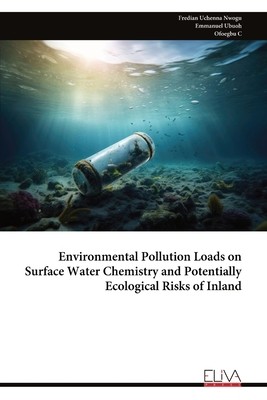
- We will send in 10–14 business days.
- Author: Fredian Uchenna Nwogu
- Publisher: Eliva Press
- ISBN-10: 9999317413
- ISBN-13: 9789999317412
- Format: 15.2 x 22.9 x 0.2 cm, minkšti viršeliai
- Language: English
- SAVE -10% with code: EXTRA
Environmental Pollution Loads on Surface Water Chemistry and Potentially Ecological Risks of Inland (e-book) (used book) | bookbook.eu
Reviews
Description
The study assessed water chemistry of Nworie inland aquatic ecosystem in South eastern, Nigeria from January, 2020 to December 2022. Water samples were taken from the upper, middle, and lower river at 200m interval. Data collected were subjected to multivariate analyses. Results of physicochemical tracers indicated mean CaCO3, Ca2+& Chemical Oxygen Demand (COD) to be 172.8mg/l, 103.1mg/l, 16.50mg/l respectively above the World Health Organisation (WHO) critical limits, while turbidity (NTU), dissolved oxygen (DO) mgl-1, chloride (Cl- ) mg/l, Magnesium (Mg) mg/l, Sodium (Na) mg/l, sulphate (SO42+) mg/l, nitrate (NO3-) mg/l, potassium (K) mg/l and phosphate (PO34) were below the limits. Heavy metals (mg/l) showed mean values viz: Cd 2+(0.053), Cr2+(0.049), Fe2+(0.443), Ni2+(0.024), and Pb (0.787) which were all above some critical global limits, except for Cu2+ and Zn2+ and in decreasing abundance: Pb2+>= Fe2+ >= Cu2+ >= Zn2+ >= Cd2+ >= Cr2+ >= Ni2. Physicochemical tracers and elements in water correlated in both positive and negative directions. Principal component analysis (PCA) showed significant loads of PC3; CaCO3, NO3, COD, DO, Ca, PO4, Cu, Fe, Zn, PC2; moderate loads of SO4, Cl, & Na originating from complex human activities. Contamination factor (Cf), recorded high for cadmium while pollution load & ecological risk recorded low in decreasing order: Cr2+ >= Zn2+ >= Ni2+ >= Cd2+ >= Pb2+ >= Cu2+ >= Fe2+ with contamination degree in order of: Lower River (LR)>=Upper River(UR) >= Middle River(MR) and low risk index. Continuous monitoring of human activities along the whole River is important to mitigate any aquatic ecosystem damage for water quality sustainability.
EXTRA 10 % discount with code: EXTRA
The promotion ends in 22d.20:37:12
The discount code is valid when purchasing from 10 €. Discounts do not stack.
- Author: Fredian Uchenna Nwogu
- Publisher: Eliva Press
- ISBN-10: 9999317413
- ISBN-13: 9789999317412
- Format: 15.2 x 22.9 x 0.2 cm, minkšti viršeliai
- Language: English English
The study assessed water chemistry of Nworie inland aquatic ecosystem in South eastern, Nigeria from January, 2020 to December 2022. Water samples were taken from the upper, middle, and lower river at 200m interval. Data collected were subjected to multivariate analyses. Results of physicochemical tracers indicated mean CaCO3, Ca2+& Chemical Oxygen Demand (COD) to be 172.8mg/l, 103.1mg/l, 16.50mg/l respectively above the World Health Organisation (WHO) critical limits, while turbidity (NTU), dissolved oxygen (DO) mgl-1, chloride (Cl- ) mg/l, Magnesium (Mg) mg/l, Sodium (Na) mg/l, sulphate (SO42+) mg/l, nitrate (NO3-) mg/l, potassium (K) mg/l and phosphate (PO34) were below the limits. Heavy metals (mg/l) showed mean values viz: Cd 2+(0.053), Cr2+(0.049), Fe2+(0.443), Ni2+(0.024), and Pb (0.787) which were all above some critical global limits, except for Cu2+ and Zn2+ and in decreasing abundance: Pb2+>= Fe2+ >= Cu2+ >= Zn2+ >= Cd2+ >= Cr2+ >= Ni2. Physicochemical tracers and elements in water correlated in both positive and negative directions. Principal component analysis (PCA) showed significant loads of PC3; CaCO3, NO3, COD, DO, Ca, PO4, Cu, Fe, Zn, PC2; moderate loads of SO4, Cl, & Na originating from complex human activities. Contamination factor (Cf), recorded high for cadmium while pollution load & ecological risk recorded low in decreasing order: Cr2+ >= Zn2+ >= Ni2+ >= Cd2+ >= Pb2+ >= Cu2+ >= Fe2+ with contamination degree in order of: Lower River (LR)>=Upper River(UR) >= Middle River(MR) and low risk index. Continuous monitoring of human activities along the whole River is important to mitigate any aquatic ecosystem damage for water quality sustainability.


Reviews